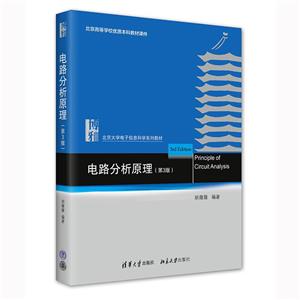目录
Contents
引子——人类认识电的历史History
第1章线性电路分析基础Introduction & Basic Analysis of Linear Circuit
1.1线性电路基本概述/Basic Introduction to Linear Circuit
1.1.1基本单位/Units and Scales
1.1.2集总假设及集总电路模型/Lumped Circuit Model
1.1.3基本元件、变量和参考方向/Basic Elements、Parameters and
Reference Direction
1.1.4基本定律/Basic Laws
1.2常见电路元件模型及其约束方程/Circuit Elements and Element
Constraints
1.2.1元件的分类/Kinds of Elements
1.2.2电阻元件/Resistor
1.2.3理想独立电压源与理想独立电流源/Independent Sources
1.2.4电容元件/Capacitor
1.2.5电感元件/Inductor
1.2.6理想受控源/Controlled Source or Dependent Source
1.3典型源信号和响应信号/Basic Signals or Functions
1.3.1信号概述/Introduction
1.3.2典型信号/Basic Signals
1.4线性二端(单口)网络的等效/Equivalence of OnePort Network
1.4.1等效的定义/Definition of Equivalence
1.4.2电阻电路的等效/Equivalence of Resistive Circuits
1.4.3具有初始储能(初始值)的动态元件的等效/Equivalence of
Dynamic Elements
1.4.4源电路的等效/Equivalence of Sources
总结与回顾Summary and Review
学生研讨题选Topics of Discussion
练习与习题Exercises and Problems
第2章线性电路的时域分析Basic Analysis of Linear Circuit in
Time Domain
2.1动态电路的暂态过程和起始状态/Introduction of Transient Analysis
2.1.1静态电路与动态电路/Static and Dynamic Circuit
2.1.2静态电路分析/Resistive Circuit
2.1.3动态电路的换路、起始状态和暂态过程/Switch and Initial State
2.2一阶动态电路分析/Analysis of FirstOrder Circuit
2.3动态电路的零状态响应/Zero State Response
2.3.1复指数信号及正弦信号激励的零状态响应/Sinusoidal Excitation
2.3.2单位阶跃响应s(t)和单位冲激响应h(t)/UnitStep Response and
UnitImpulse Response
2.3.3任意信号激励的零状态响应/Arbitrary Excitation
2.4二阶及高阶动态电路分析/SecondOrder Circuits
and HighOrder Circuits
2.4.1响应的求解/Functions and Solutions
2.4.2电路的稳定性分析/Stability Analysis
*2.5电路的状态分析/State Variable Analysis
2.5.1状态和状态变量/State and State Variables
2.5.2状态变量法/State Variable Description
总结与回顾Summary and Review
学生研讨题选Topics of Discussion
附录A一元 n次常系数微分方程的求解Solution of nthOrder
Differential Equation
A.1一阶线性常系数微分方程的求解/First Order
A.2n阶微分方程的求解/nthOrder
练习与习题Exercises and Problems
《电路分析原理(第3版)》·目录Principle of Circuit Analysis,3rd Edition
第3章正弦稳态电路分析Sinusoidal SteadyState Analysis
3.1正弦稳态电路/Sinusoidal SteadyState Circuit
3.1.1正弦信号的复数表示——相量/Phasor
3.1.2电路的复数表示——相量模型/Phasor Model in Circuit
3.1.3稳态电路分析/SteadyState Circuit Analysis
3.2正弦稳态功率/Powers
3.3网络函数与频率响应/Network Functions and Frequency Responses
3.4滤波器/Filter
3.4.1一阶滤波器/FirstOrder Filter(LowPass,HighPass)
3.4.2二阶滤波器/SecondOrder Filter(Band Pass,Band Stop)
总结与回顾Summary and Review
学生研讨题选Topics of Discussion
练习与习题Exercises and Problems
第4章电路的变换域分析——拉普拉斯变换Laplace Transform
4.1拉普拉斯变换/Laplace Transform
4.1.1变换域分析/Transform Analysis
4.1.2拉普拉斯变换定义/Definition of the Laplace Transform
4.1.3拉普拉斯变换的基本性质/Basic Properties and Theorems of the
Laplace Transform
4.1.4拉普拉斯反变换/Inverse Laplace Transform
4.2线性电路的s域求解/Circuit Analysis in the s Domain
4.2.1元件的s域模型/Elements in the s Domain
4.2.2定律的s域形式/Laws in the s Domain
4.2.3电路的s域求解/Circuit Analysis in the s Domain
4.3网络函数的s域描述/Network Function in the s Domain
4.3.1定义/Definition
4.3.2网络函数的特性/Characteristic Analysis
总结与回顾Summary and Review
学生研讨题选Topics of Discussion
练习与习题Exercises and Problems
第5章信号的变换域分析——傅里叶分析Fourier Analysis
5.1傅里叶级数/The Fourier Series
5.1.1周期信号的傅里叶级数表示/Three Forms of the Fourier Series
5.1.2周期信号的对称性与傅里叶级数之间的关系/Symmetry of Fourier Series
5.1.3常见周期信号的傅里叶级数/Some Useful Fourier Series
5.1.4周期信号的平均功率和有效值/Average Power and Effective
Values of Periodic Functions
5.1.5周期信号作用于线性电路的稳态响应/SteadyState Responses
5.2傅里叶变换: 非周期信号的频谱分析/Fourier Transform
5.2.1从傅里叶级数到傅里叶变换/From Fourier Series to Fourier Transform
5.2.2傅里叶变换与反变换/Some Useful Fourier Transform Pairs
5.2.3傅里叶变换的基本性质与定理/Basic Properties and Theorems of the
Fourier Transform
5.2.4傅里叶变换与拉普拉斯变换/Fourier Transform and Laplace Transform
5.3信号通过常参量线性电路/Signal Forcing in Linear Circuits
5.3.1信号通过电路的波形失真/Wave Distortion
5.3.2电路的因果律与理想滤波器/Causality and Ideal Filter
*5.4采样定理/Sampling Theorem
总结与回顾Summary and Review
学生研讨题选Topics of Discussion
练习与习题Exercises and Problems
第6章网络的拓扑分析Network Topology Analysis——Mesh and
Nodal Analysis
6.1支路电流法 / Branch Current Analysis
6.2网络拓扑分析的基本知识/An Introduction to Network Topology
6.2.1图论分析中的名词/Some Definitions in Network Topology Analysis
6.2.2基本公式与推论/Formula and Conclusions
6.3网孔电流法与回路电流法/Mesh Current Analysis and Loop
Current Analysis
6.3.1回路电流法/Loop Current Analysis
6.3.2网孔电流法/Mesh Current Analysis
6.3.3含电流源支路的处理/Solution Involving Current Sources
6.4节点分析法/Nodal Analysis
6.4.1节点电压法/Nodal Voltage Analysis
6.4.2含电压源支路的处理/Solution Involving Voltage Sources
*6.5大网络拓扑分析/Topology Analysis
6.5.1节点分析/General Nodal Analysis
6.5.2回路分析/Loop Analysis
总结与回顾Summary and Review
学生研讨题选Topics of Discussion
练习与习题Exercises and Problems
第7章网络定理Theorems in Circuit Analysis
7.1存在和唯一性/Existence and Uniqueness
7.2置换定理/Substitution Theorem
7.3叠加定理/Superposition Theorem
7.4戴维南定理和诺顿定理/Thevenins Theorem and
Nortons Theorem
7.5互易定理/Reciprocity Theorem
*7.6特勒根定理/Tellegens Theorem
总结与回顾Summary and Review
学生研讨题选Topics of Discussion
练习与习题Exercises and Problems
第8章双口网络分析TwoPort Network Analysis
8.1双口网络参量概述/Introduction
8.1.1双口网络参量及其相互转换/TwoPort Network Parameters
8.1.2双口网络参量与网络连接/TwoPort Network Connections
8.2Z参量和Y参量/Z and Y Parameters
8.2.1Z参量的定义/Z Parameters
8.2.2T形等效电路/Ttype Equivalent Circuit
8.2.3Y参量的定义/Y Parameters
8.2.4π形等效电路/πtype Equivalent Circuit
8.3混合参量/Hybrid Parameters
8.3.1H参量的定义/H Parameters
8.3.2G参量的定义/G Parameters
8.3.3等效电路/ Equivalent Circuit
8.4传输参量/Transmission Parameters
8.5有端接的双口网络/TwoPort Network with Input and Output
8.5.1网络函数/Network Functions
8.5.2阻抗变换和阻抗匹配/Impedance Transform and Impedance Matching
*8.6有源双口网络/Active TwoPort Network
总结与回顾Summary and Review
学生研讨题选Topics of Discussion
练习与习题Exercises and Problems
第9章均匀无耗传输线The Uniform Lossless Transmission Line
9.1分布参数电路/Distributed Parameter Circuit
9.2传输线方程/Transmission Line Equations
9.2.1传输线的分布参数模型/Circuit Model
9.2.2一般传输线方程/Line Equations
9.2.3传播常数、入射波和反射波/Propagation Constant,Incident
Wave and Reflected Wave
9.2.4特性阻抗与无限长传输线/Characteristic Impedance and
Infinite Line
9.2.5双口网络等效/TwoPort Network Equivalence
9.3均匀无耗传输线上的波动/Wave on Lossless Line
9.3.1双口网络方程/TwoPort Network Equation
9.3.2电压和电流反射系数/Reflection Coefficient
9.3.3终端负载与反射波/Load and Reflected Wave
9.3.4终端负载与阻抗匹配/Load and Impedance Matching
9.4均匀无耗传输线的阶跃响应/Step Response
*9.5微波双口网络的散射参量/Scattering Parameters
总结与回顾Summary and Review
学生研讨题选Topics of Discussion
练习与习题Exercises and Problems
第10章非线性电路分析简介Nonlinear Circuit Analysis
10.1非线性电路的分析方法/Introduction to Nonlinear Circuit Analysis
10.1.1解析法/Analytical Method
10.1.2图解法/Graphical Method
10.1.3折线法/PiecewiseLinear Technique
10.2非线性器件的双口网络分析/TwoPort Network of
Nonlinear Devices
10.2.1三极管的小信号模型/SmallSignal Model of Transistor
10.2.2运算放大器/Operational Amplifer
总结与回顾Summary and Review
学生研讨题选Topics of Discussion
练习与习题Exercises and Problems
中英文索引CE Index
英中文索引EC Index
表格索引Table Index
参考文献References





















